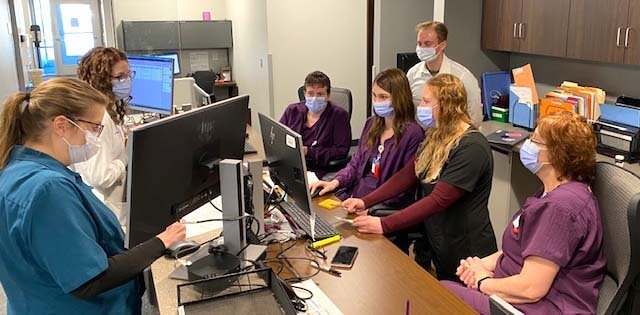December 9, 2020
Team-based Care On the Rise
When Dr. Chris Thompson and others heard about team-based care two years ago, he was all ears. “We’ve been trying to figure out how to provide care differently for a long time,” said Thompson, who is a family medicine physician. “Everybody who works in healthcare feels tremendous stress around change and shifting responsibilities and expectations. The old model just isn’t sustainable. We can’t keep doing what we’ve done and meet all the changing needs.”

For Dr. Thompson, finding a more efficient way to deliver care was just one part of the equation. “In particular, we also saw this as an opportunity to capture more joy in our work,” he said. “We know that when people enjoy their work and feel purpose in what they do, they’re at their best and will take the best care of their patients that they can.”
Trying Team-based Care
Team-based care puts emphasis on leveraging the skills of the entire team. Ultimately, the patient is the entire team’s responsibility. “The traditional primary care models are very hierarchical and not very efficient,” said Dr. Nate Brever, family medicine physician at Albany Clinic. “With team-based care, it’s not my patient, it’s our patient. We all have opportunities to connect with the patient and be their advocate.”
“With team-based care, it’s not my patient, it’s our patient. We all have opportunities to connect with the patient and be their advocate.”
Along with Albany Clinic Manager Tressa Schmidt, Dr. Brever started implementing this new model. But two months in, it just wasn’t working. The team was trying to be efficient, but it didn’t feel right. So they stopped and started over. “We have a culture where it’s okay to try things and say, ‘that didn’t work,’” said Schmidt. “And when something doesn’t work, we ask the team for their ideas and try something else. If we didn’t fail, then it means we didn’t try.”
A Team Culture
The team regrouped and tried again. It took a while, but things started to click. They credit their success to the fact everyone bought into the model. “We’ve worked hard to create a culture that our patients can feel when we’re in the room with them,” said Dr. Brever. “The patient needs to know that we’re all there to help them, and I think that’s made a difference.”
In Albany, the clinic teams are all-in on team-based care. There are now three different care teams, each with a dedicated mix of physicians, PAs, RNs, Care Team Coordinators (LPNs or CMAs) and patient access staff. And while it took some time to adjust, you can feel the energy when the team talks about the difference it has made.
We get to know our patients better and we help each other get our work done. We’ve come a long way.”
“I worked with a different provider for 20 years and had just started working with Dr. Brever in July,” said Carol Dobmeier, LPN and Care Team Coordinator. “When he first told me that we were going to try this, I’m sure I had a look on my face that said, “do you realize what you’re doing here?” she laughs. “We worked through some early hiccups, but it’s been great. We get to know our patients better and we help each other get our work done. We’ve come a long way.”
Dr. Chris Thompson agrees and is pleased to see team-based care starting to take hold. “It has allowed me to focus on the patient and help them be healthier in whatever ways are needed,” he said. “I can’t do that by myself so having the team partner with me is a tremendous relief because I can share the care of my patients with them, and they enjoy doing it.” He’s also felt the impact at home. “This work allows me to feel like I’ve taken the best care of our patients during the day and I still have the energy I need to be a husband and father when I go home to be with my family.”

